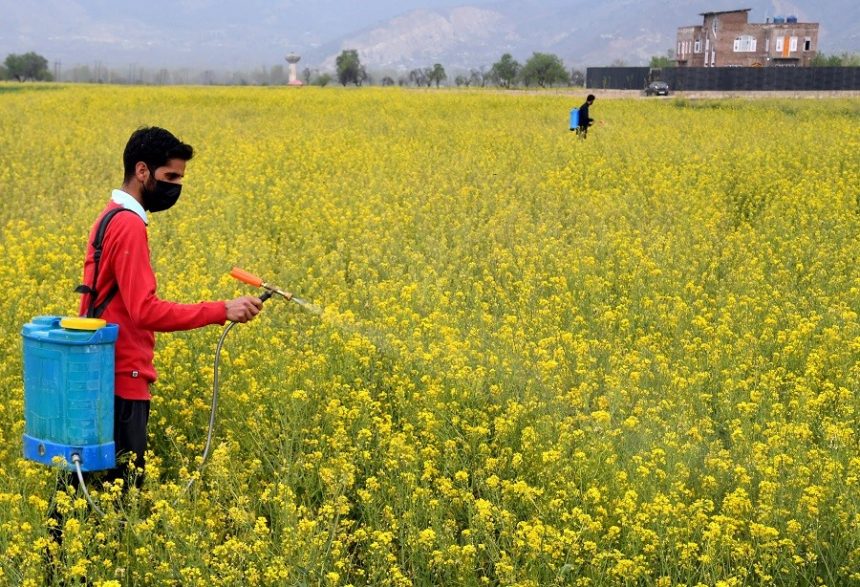Amid rising oil prices across the country, Kashmir Valley has experienced a significant mustard boom, with a noticeable increase in mustard cultivation over the years. Farmers in the region are reaping promising yields, leading to both economic relief and a shift towards local oil production.
Nazir Ahmad, a farmer from Pattan who owns five kanals of land, said many farmers in his area, who had long abandoned mustard cultivation, have returned to it over the past three years. “Some of them are sowing mustard again after a gap of six or even seven years,” he added.
Over the past several years, the Agriculture Department has been consistently promoting mustard cultivation, and their efforts appear to be bearing fruit. This year, more farmers have shown renewed interest in growing mustard, seeing it as both a profitable and sustainable option.
“Mustard offers multiple benefits for farmers,” Nazir explained. “It allows us to extract oil every year from our land, and once mustard is harvested, we still have time to sow a second crop. With the price of edible oils on the rise, mustard farming is becoming a smart economic choice.”
Farmers also credit last year’s favorable weather conditions for a significant boost in mustard production. The yield nearly doubled, thanks to a combination of good weather and an increase in the total land under cultivation.
Feroz Ahmad, a farmer from Tangmarg, echoed similar sentiments. “Farmers should focus on crops that bring solid economic returns and help improve household income,” he said.
“Earlier, we struggled with poor-quality seeds, but now, with support from the Agriculture Department, we are getting high-quality hybrid seeds that have the potential to double our output.”
Farmers said cultivating mustard offers several benefits for the soil, including improving soil structure, suppressing weeds and pests, and acting as a biofumigant, all contributing to healthier and more fertile land.
Over the years, the Valley has witnessed remarkable success in mustard oilseed farming. In fact, the Agriculture Department revealed that during 2022–23, a record 1.5 lakh hectares of land were brought under oilseed cultivation—a milestone for the region.
According to officials from the department, the area under oilseed cultivation has seen a steady rise. In 2021–22, around 1 lakh hectares were allocated for oilseeds, a significant jump from just 30,000 hectares in 2020–21 dedicated to mustard cultivation.
Oilseeds are now grown across almost all areas of the Kashmir region, with key producing districts including Anantnag, Srinagar, Kupwara, Budgam, and Baramulla.
The growing popularity of mustard farming in the valley is largely attributed to the sharp rise in edible oil prices, prompting many farmers to turn to this economically viable crop.
Agriculture officials have hailed the significant expansion of mustard cultivation as a major achievement for the department, calling it a landmark success. They expressed satisfaction over bringing a record area of land under mustard cultivation across the region.
Experts believe this increase in oilseed production will help reduce the soaring prices of edible oils. “This development will lower dependence on imported processed mustard oil and, in turn, help ease the overall cost of edible oils,” an agriculture expert said.
The expert also emphasized the importance of adopting drought-tolerant mustard varieties through advanced plant breeding programs, including selection and hybridization between introduced lines. These efforts, he said, could prove critical in addressing the challenges currently facing oilseed production.
“To further boost oilseed production under both rainfed and irrigated conditions, we need to implement key strategies,” the expert added. “These include expanding irrigation coverage, practicing effective moisture conservation techniques like mulching, timely weed control, proper seed selection and sowing methods, growing climate-resilient varieties, adopting integrated nutrient and pest management practices, and encouraging intercropping.”
As part of its broader agricultural strategy, the Department of Agriculture, Kashmir, has intensified its efforts under the National Mission on Edible Oils, aiming to double the area under mustard cultivation. The initiative aligns with the Prime Minister’s vision of doubling farmers’ income.
Officials said the mission has already shown promising results. Not only does the expansion of mustard cultivation promise economic benefits, but it also aids in pollination and the flowering of horticultural crops. “Oilseed cultivation holds vast potential in the Valley,” officials said. “Its productivity here is significantly higher than in many other parts of the country.”
They further highlighted that mustard produced in Kashmir has a superior oil recovery rate compared to other regions, making it a key driver in the department’s push to expand cultivation of this vital crop.
Several years ago, the Agriculture Production Department laid out a detailed roadmap for the promotion of oilseed cultivation under the Holistic Agriculture Development Program (HADP), which has since received considerable attention and support.
In Kupwara district, mustard cultivation has reached a new milestone, with the agriculture department expecting a bumper harvest this year. Officials reported that 6,700 hectares of land were brought under oilseed cultivation during the 2022–23 Rabi season—up from 4,300 hectares in 2021–22, marking a record achievement for the frontier district.
“We have been working in mission mode over the past two years to expand mustard cultivation and enhance farmer incomes,” said an official from Kupwara.
Mustard, a versatile crop, plays an important role in Kashmir’s agricultural calendar. It is cultivated annually, with planting beginning in October and harvests taking place from late April to May. It is grown both as a primary and secondary crop, supporting the Valley’s diversified farming practices.








